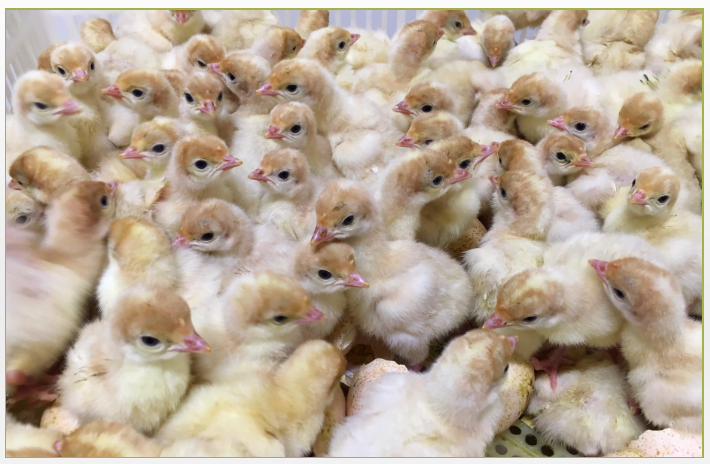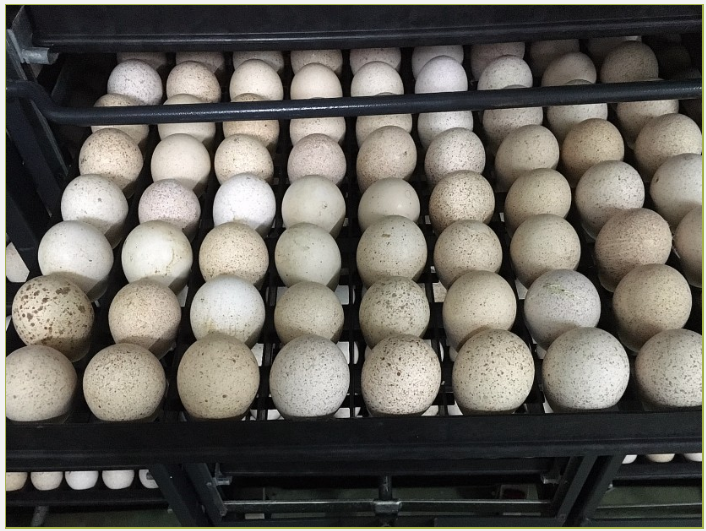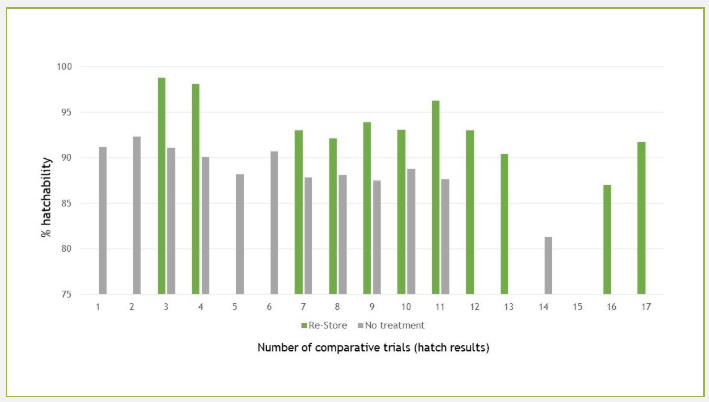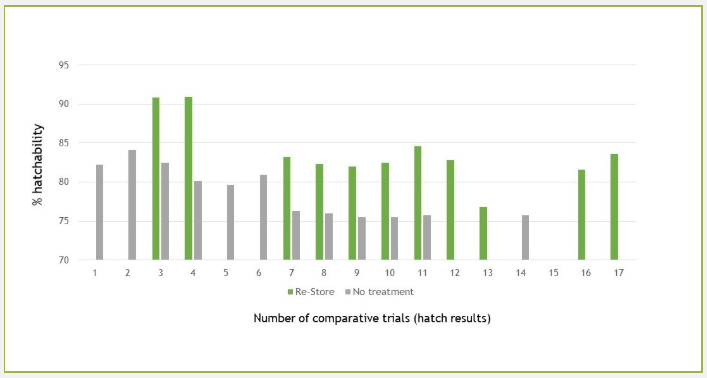



The specific requirements and sensitivities of turkey egg incubation
Turkey eggs have a high incubation success rate when all the species-specific areas of incubation are managed correctly. Hence, a suite of incubation equipment that allows for fine-tuning of the processes and parameters is more than worth the investment.
Nature as a reference
The natural hatching process is the starting point of Petersime’s incubation philosophy. We always try to emulate the experience the embryo has in the nest. Embryo-Response Incubation™, as this method is called, involves technology that caters explicitly to the specific demands of different bird species.
This article explores the three key areas of Petersime’s Embryo-Response Incubation™ technology as it relates to turkey incubation:
- 1. The BioStreamer™ Re-Store incubator for heat treatment of stored eggs with short periods of incubation.
- 2. Operational Excellence™ setter technology, particularly the automated eggshell temperature measurement device as a means of regulating air temperature and CO2 levels to control ventilation and moisture loss.
- 3. Operational Excellence™ hatcher technology and, specifically, CO2 as a means of controlling ventilation and humidity.

Heat treatment of stored turkey eggs
Natural mating in turkey flocks is rarely practiced. Artificial insemination means that fertility rates have the potential to be very high. And yet, the viability of these fertile eggs often turns out not to reach its full potential. A possible cause is the wide spread of embryological development in the turkey eggs when they are delivered to the hatchery.
The different stages of embryological development were identified and classified by Eyal-Giladi and Kochav, and Hamburger and Hamilton. Research suggests that the stage that offers the best survivability of the embryo during the storage period in the hatchery is stage thirteen. Eggs in earlier stages tend to be more susceptible to perishing during storage. Comparing turkey eggs to chicken eggs shows that almost 60% of turkey eggs are in pre-development stage ten when delivered to the hatchery.
One way of preventing early embryological loss in turkeys is to use heat treatment during storage in a dedicated Petersime BioStreamer™ Re-Store machine to advance embryological development to stage thirteen and so unify the overall spread of stages. Trials with research partners have proved the benefits of using heat treatment for turkey eggs.


Subsequent Re-Store treatments on eggs stored for an extended period of time improve hatchability by restoring cell growth and survivability of eggs returning to storage. Not only does this procedure improve viability of the fertile eggs; it also lends itself – in combination with setter and hatcher technology – to achieving a more narrow hatch window.
Distinctive setter and hatcher technologies
When incubation commences, measuring and applying set points to CO2, as well as making the CO2 level guide the ventilation rates, can spare the embryo from any dramatic changes to its gaseous environment. In this way, the environment can be tailored to the specific and ever-changing gaseous exchange requirements of the embryo to stimulate strong vascular development and achieve target weight loss figures.
A developing embryo sheds two waste products – CO2 and water – leading to weight loss
By shedding water progressively, an egg reduces in weight. Weight loss in a fertile egg manifests itself in the size of the air cell on the blunt end of the egg. This is the air cell the hatchling first breaks through when it starts to hatch. The ideal weight loss at transfer is roughly 10% of the egg’s weight when it first commences incubation. Not achieving this target usually points to an unhealthy hatchling.
An automated eggshell temperature measurement device makes it possible to control the environment of the developing and constantly changing embryo so that it can thrive in an ideal environment for all its needs specific to its stage of development.
Trials with turkeys have shown that the critical transition from the endothermic to exothermic phases of incubation require a lower temperature than other species. This has led to a specific turkey eggshell temperature programme that is unique compared to other species.
Turkeys eggs are especially sensitive to temperature
The turkey industry is also unique in itself because of the varying market requirements: some markets prefer small-framed turkeys, some medium-framed, and yet others want very large-framed birds. These differences are even present during the embryological stage and can require different temperature environments.
To cater for this, the eggshell temperature programme, which is gradually and progressively raised from the beginning of the exothermic phase through to transfer, can be adjusted according to the size of the turkey breed being incubated. This principle should always be adhered to, irrespective of turkey breed.
Hatcher management
The hatching of turkey poults is an art in itself. While other species might be forgiving of hatcher environment mismanagement, turkeys are not. Indeed, there are many species-specific considerations that make correct management of the hatcher most critical.
To develop the ideal hatcher environment for turkeys, Petersime has conducted trials looking into different fan speeds and the impact this control factor has on key moments in the hatching process.
By progressively lowering fan speeds during the period of hatching, a precise fan speed was found at which mortality significantly decreased. The conclusion drawn was that fan speeds directly impact the energy levels the poults must expend during hatching. Higher fan speeds caused energy depletion, i.e. poults were unable to complete the process of hatching. Reduced fan speeds were friendlier to the poults and enabled them to complete the hatching process without succumbing to exhaustion. This led to the development of a turkey hatcher with fan speeds that differ from the programmes used for other species.
The importance of the right humidity and CO2 levels
Managing humidity in the turkey hatcher may not be unique in itself, but it is certainly defining to the Petersime Embryo-Response Incubation™ philosophy. As the poults are particularly temperature-sensitive, the action of spraying causes the temperature to fluctuate. It is therefore better to avoid the use of humidity sprays. Humidity is, however, essential during hatching to keep the shell membranes moisturised. To enable a humidity-rich environment that is conducive to the hatching poults fully extracting themselves from their shells, we let the level of CO2 control the level of ventilation, in the same way it was done in the setter.
To stimulate late-acting birds to complete their hatch, our programme calls for an increase in CO2. To accommodate for this, ventilation levels are reduced. As this coincides with the hatching of the eggs, naturally released humidity will be captured inside the machine. This humidity has no detrimental effect on the temperature.On the contrary, it helps moisturise shell membranes, thereby allowing poults to hatch without expending too much energy.
Timing, here, is critical for success. If CO2 is increased too early, the late hatching poults will grow accustomed to their environment and will no longer perceive it as a stimulus. Ideally, the process corresponds with the commencement of the hatch, tightening the hatch window and reducing the incidence of pipped alive poults. This completes the work kickstarted by the Re-Store heat treatment and maintained by the Operational Excellence™ setter.
The luxury of Petersime’s turkey incubation equipment
In conclusion, turkeys imply many species-specific considerations when it comes to incubation management. Petersime’s suite of incubation equipment — with its unique Embryo-Response Incubation™ technology — gives turkey hatcheries the luxury of being able to identify the critical details, and the assurance of knowing that they can cater to them precisely. By understanding where the gains in turkey hatchability can be found and by correctly using the Petersime technology, there is an amazing scope for continuous improvement.








